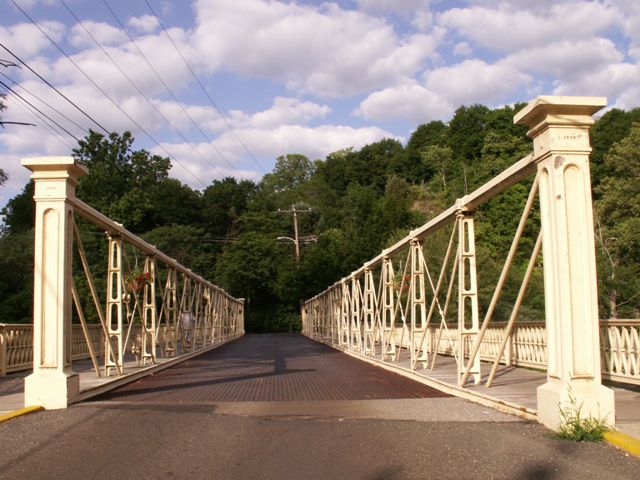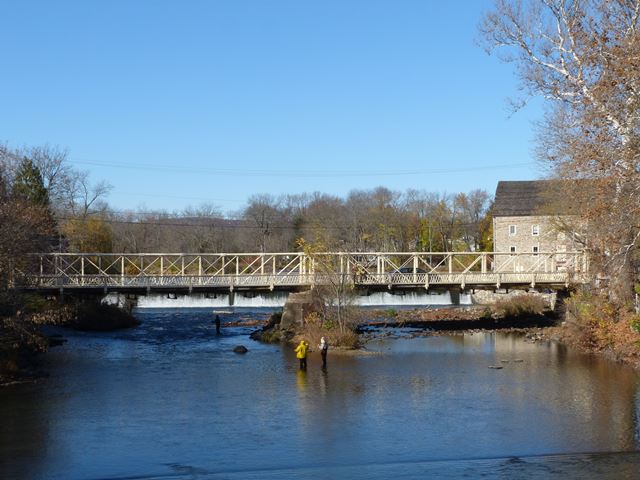We Recommend:
Bach Steel - Experts at historic truss bridge restoration.
BridgeHunter.com Phase 1 is released to the public! - Visit Now
Main Street Bridge

Primary Photographer(s): Nathan Holth and Rick McOmber
Bridge Documented: July 11, 2008 and November 8, 2015
Clinton: Hunterdon County, New Jersey: United States
1870 By Builder/Contractor: William Cowin of Lambertville, New Jersey and Engineer/Design: Francis C. Lowthrop
1938
85.0 Feet (25.9 Meters)
170.0 Feet (51.8 Meters)
15.7 Feet (4.79 Meters)
2 Main Span(s)
10XX0N1

View Information About HSR Ratings
Bridge Documentation
View Archived National Bridge Inventory Report - Has Additional Details and Evaluation
View Historic American Engineering Record (HAER) Documentation For This Bridge
HAER Drawings, PDF - HAER Data Pages, PDF
View the Original Francis C. Lowthorp patent for the design of this bridge.
View the Original William Johnson patent for the design of this bridge's tension adjustment.
View Historical 1920 Article Discussing Lowthorp Bridges At Clinton
About The Three Cast Iron Trusses In Hunterdon County
This bridge's design was created by Francis C Lowthorp. Lowthorp's name is often misspelled as Lowthrop. Lowthorp is correct and is how it is spelled on the original patent. The bridge was constructed by WM Cowin, which was a company run by William and Charles Cowin.
This bridge is one of three bridges in Hunterdon County which follow the Lowthorp design and were built by Cowin, and they are the only three such bridges in the whole state which utilize cast iron for all compression members/chords on the bridge. These bridges are among a small and elite group of metal truss bridges in the nation, as cast and wrought iron bridges. As pre 1880 bridges, they also are among the oldest metal truss bridges in the country, which is unsurprising given the use of cast iron in the bridges. Cast iron was rapidly replaced by wrought iron for bridge construction after 1800. As extremely old bridges, using cast iron for major structural components, the three Lowthorp/Cowin bridges in New Jersey are among the most important group of historic bridges in the United States.
The Lowthorp/Cowin truss bridges are a true expression of what makes historic metal truss bridges so special. The bridges have a complex appearance to them, yet in the same way they are also simple in their overall design. In design, these bridges are simply pin-connected Pratt pony trusses with vertical members. However, the detail and design in the form of the cast iron beams and components on this bridge is truly remarkable. There are no decorations or embellishments added to the bridge, the decoration and embellishment is the bridge's structural components themselves. Because the components were cast rather than rolled like wrought iron or steel beams, this allowed the fabricator of the bridge to shape the beams in any way they desired. Advantage was taken of this property, and this is evident in the architectural design and treatment of the various cast iron components on the bridge. This property of cast iron also eliminated the need for a separate bridge plaque; instead, information is cast directly on the top chord of the bridge. This would not be found with rolled beams of wrought iron or steel. While the name/brand of the metal is often found on rolled beams, this is a permanent part of the equipment which rolls the beams and cannot be changed easily as a result.
About The Main Street Bridge
The historic bridge inventory mentions "The Clinton bridge, based on its age, use of materials, design, and documentation, is one of the most important bridges in the nation." This is an accurate statement. Indeed, all three of the Lowthorp/Cowin truss bridges are among the most important bridges in the country. Of those three bridges, the Main Street Bridge is the longest and the only multi-span example. The bridge is also skewed, which only adds to its significance. The Main Street bridge fits well into a historical setting, with the nearby historic Red Mill which functions as a museum. The setting is an important and unique historical landscape.
This bridge has William Johnson's patented diagonal tension adjusting devices located on the bottom chord. However, they are hard to see on this bridge because of the deck layout. The School Steet Bridge in Glen Gardner also has these devices and they are much easier to see there. Visit that bridge's page to view a detailed diagram and description of the tension adjusting devices.
While the bridge is on a short residential street, future preservation work to consider for this bridge might be the installation of low-profile guardrails on this bridge to protect it from vehicular damage. The railings should be low profile however and not obstruct the bridge.
Information and Findings From New Jersey's Historic Bridge InventoryDiscussion of Bridge SUMMARY: The 1870 cast and wrought iron Pratt pony truss bridge built by Lambertville contractor William Cowin using the patented design of Francis C. Lowthrop, ranks as one of the historically and technologically significant metal truss bridges in the state. The 2-span bridge with cast verticals and top chord is important in the evolution in materials and design used in bridge building in the mid-19th century transition from wood to iron to steel. The bridge was documented by HAER in 1991-1992. BIBLIOGRAPHY:
Hunterdon County Engineer's Office Bridge card N1, L-90W, G63. PHYSICAL DESCRIPTION: The two span pin-connected Pratt pony truss was fabricated in 1870 by William Cowin as designed by Francis Lowthorp. It uses cast iron for compression members and wrought iron for tension elements. The cast top chord is fitted together with pressure joints. The name of the fabricator is cast into the piece. Diagonals are loop forged eyerods. An unusual feature is the patented Johnson tightener, an eccentric ratchet and pawl arrangement at the panel point for tuning the bridge. Cast vertical members are tapered. Some principal diagonals have a screw adjustment mechanism, but not all. Floor beams are unusual in the use of two rods in an inverted Kingpost truss arrangement which may be adjusted to increase tension. The bottom lateral sway bracing rods screw into a center ring for adjustment. The last segment of the bottom chord is an articulated cast member, designed to absorb temperature expansion and contraction. The vertical cast Italianate column end posts give the date of construction. Sidewalks with decorative cast railings grace each side of the bridge. HISTORICAL AND TECHNOLOGICAL SIGNIFICANCE: The Clinton bridge is one of three remaining bridges constructed by Lambertville fabricator William Cowin, using the design of F.C. Lowthorp (1810-1890). The use of cast and wrought iron reflects a period of experimentation using new materials in bridge construction. Designers were still discovering the strengths and weaknesses of metal, compared to the earlier timber trusses. Emphasis was placed on examining materials under varying stress conditions. Quality control had become an issue. Lowthorp, who spent at least part of his childhood in Lambertville, was a noted designer of several railroad bridges including a two level bridge across the Delaware River at Easton to connect the Lehigh Valley, the New York Central and the Belvidere and Delaware lines. Lowthorp advocated the use of cast iron in compression, declaring in a paper delivered to the American Society of Civil Engineers, "there is much more to be feared from defects in wrought iron used for tensile than for cast iron used for compressive purposes." Lowthorp's distrust of wrought iron, based on experiments he conducted to test each element before acceptance, were prompted by the inability to control impurities in the metal and the shortage of skilled foundry men. William Cowin was the fabricator for all three remaining Lowthorp design bridges (N1, L-90W, G63). In addition to these, an Engineering News Record article (11/11/20, p.925) refers to an 1859 cast and wrought iron bridge in Clinton built by William and Charles Cowin. Darnell dates Cowin's production as 1868 to 1870. More research is required to determine if Cowin was involved with the Lambertville Iron Works which also began production in 1859 and operated throughout the century. Although the village of Clinton has four properties individually listed on the National Register (Clinton Historical Museum 1/08/74, Dunham's Mill-Parry's Mill 4/15/82, Music Hall 5/07/82, and Old Grandin Library 11/01/74), it is not listed as a district. The bridge is located slightly downstream from the mill dams and adjoins the two mill properties. It is an integral aspect of the farm to market cycle which dominated the town's past and a significant element in the character of the present street scape. The Clinton bridge, based on its age, use of materials, design, and documentation, is one of the most important bridges in the nation. When compared with the other two remaining near-by bridges (one of which, Glen Gardner Pony Pratt Truss Bridge, is on the National Register 9/22/77), it gives insight into the thought processes of the designer and fabricator and the technological imperatives which they faced. The historical context of the bridge remains and has been enriched by the re-use of one mill complex as a historical museum. The integrity of the site allows insight into daily farm-town transactions and relationships. The size and extraordinary detailing of the bridge reveals civic pride and optimism. The bridge possesses both historical and technological significance. Discussion of Surrounding Area The bridge, located in the center of the town of Clinton, carries one-way traffic of the main street over the river. It is adjacent to a pond and dam, the Clinton Historical Society, housed in Hunt's Mill built in 1810 (listed in NR 01/74), and the Hunterdon Art Museum housed in Dunham-Perry's Mill listed in NR 4/82). The center is dominated by well-preserved and well-maintained 19th- and 20th century commercial buildings. A bypass highway relieves traffic pressure on the center. Historic Bridge Management Plan Evaluated: Yes Bridge Considered Historic By Survey: Yes |
![]()
Photo Galleries and Videos: Main Street Bridge
2008 Bridge Photo-Documentation
Original / Full Size PhotosA collection of overview and detail photos. This gallery offers photos in the highest available resolution and file size in a touch-friendly popup viewer.
Alternatively, Browse Without Using Viewer
![]()
2008 Bridge Photo-Documentation
Mobile Optimized PhotosA collection of overview and detail photos. This gallery features data-friendly, fast-loading photos in a touch-friendly popup viewer.
Alternatively, Browse Without Using Viewer
![]()
2015 Bridge Photo-Documentation
Original / Full Size PhotosA collection of overview and detail photos. This gallery offers photos in the highest available resolution and file size in a touch-friendly popup viewer.
Alternatively, Browse Without Using Viewer
![]()
2015 Bridge Photo-Documentation
Mobile Optimized PhotosA collection of overview and detail photos. This gallery features data-friendly, fast-loading photos in a touch-friendly popup viewer.
Alternatively, Browse Without Using Viewer
![]()
Maps and Links: Main Street Bridge
Coordinates (Latitude, Longitude):
Search For Additional Bridge Listings:
Bridgehunter.com: View listed bridges within 0.5 miles (0.8 kilometers) of this bridge.
Bridgehunter.com: View listed bridges within 10 miles (16 kilometers) of this bridge.
Additional Maps:
Google Streetview (If Available)
GeoHack (Additional Links and Coordinates)
Apple Maps (Via DuckDuckGo Search)
Apple Maps (Apple devices only)
Android: Open Location In Your Map or GPS App
Flickr Gallery (Find Nearby Photos)
Wikimedia Commons (Find Nearby Photos)
Directions Via Sygic For Android
Directions Via Sygic For iOS and Android Dolphin Browser
USGS National Map (United States Only)
Historical USGS Topo Maps (United States Only)
Historic Aerials (United States Only)
CalTopo Maps (United States Only)



